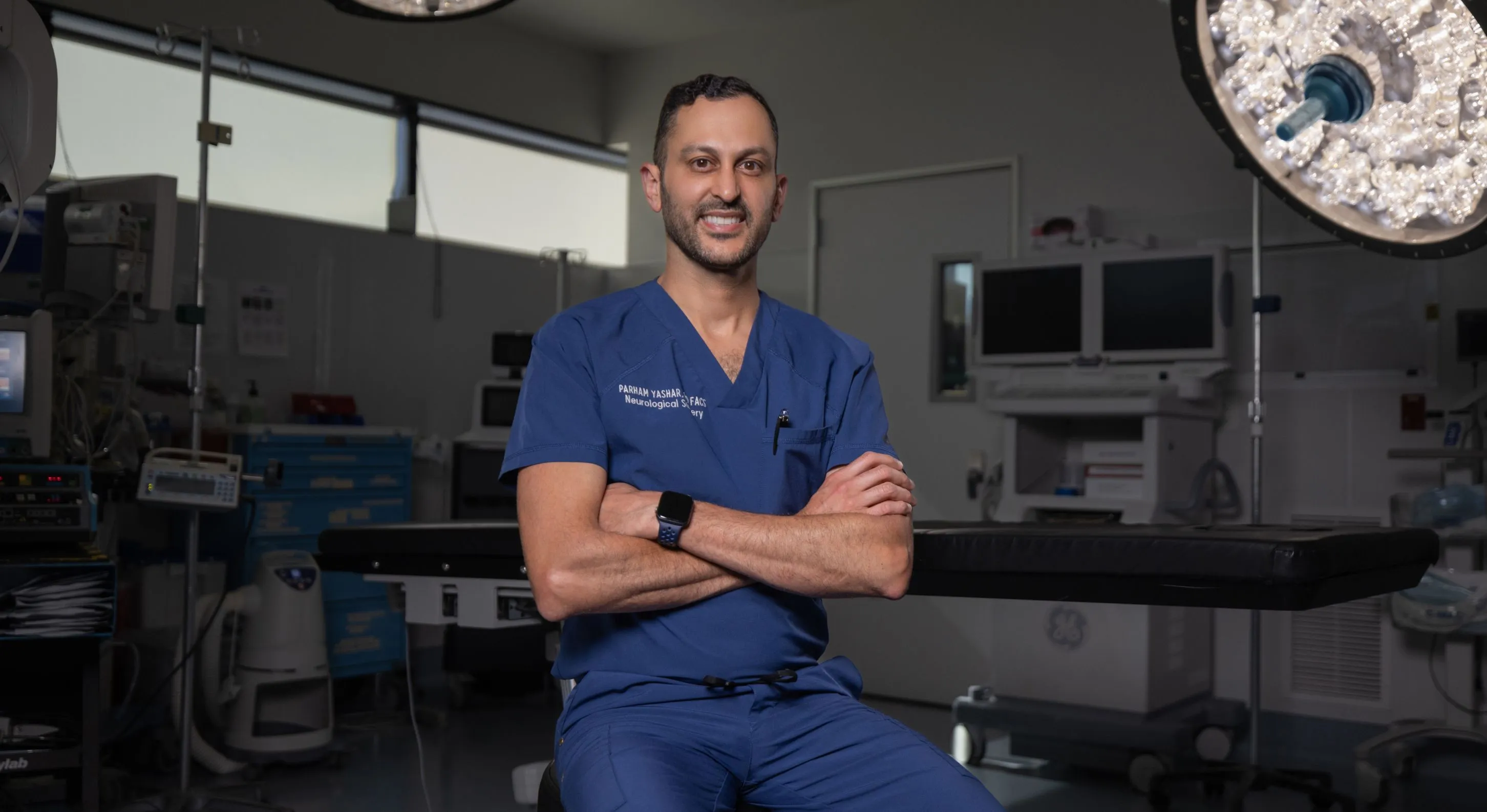



The Los Angeles Neurosurgery Expert
Resolve Complex Conditions, Manage Pain, and Recover Faster with Expert Spine Surgery and Brain Surgery







Trust Your Spine and Brain Health with the Top Neurosurgeon in the Country
Led by expert, board-certified neurosurgeon Dr. Parham Yashar, we bring an elevated approach to custom-tailored, expert, minimally invasive, and advanced neurosurgical techniques to restore your neurological function and health.




When facing a frightening or complex spine or brain condition, our compassionate team at Yashar Neurosurgery is here to support you, empowering your healing with clarity and compassion.
Whether addressing a spinal condition, such as trauma, requiring fusion, disc replacement, or a complex brain issue, such as an aneurysm or stroke, Dr. Yashar offers advanced, minimally invasive surgical solutions tailored to each patient’s unique anatomy, lifestyle, and long-term goals.


We don’t just perform surgery, we help you heal.
Post-operative care is just as important as the procedure itself. That’s why we follow up, stay in touch, provide a cutting-edge recovery facility right here on the premises, and remain available months later, helping you optimize your recovery for long-term health.

Why Los Angeles Patients Trust Dr. Yashar with Their Spine and Brain Surgery in Los Angeles




We take a deeply personalized approach to every case because no two patients are the same. Whether you're facing a spinal condition or a brain issue such as a tumor or aneurysm, we offer cutting-edge, minimally invasive options tailored to your unique anatomy, lifestyle, and goals. Led by the board-certified, fellowship-trained, best spine surgeon in Los Angeles, Dr. Parham Yashar, your path to restored quality of life has never been in better hands.




Dr. Yashar sees neurosurgery as a partnership built on trust and open dialogue. You’ll never be rushed. Every question is welcome, and you’ll be listened to with patience and clarity. We're here for however long it takes to help you feel informed, comfortable, and confident. We believe that understanding is power. From your first visit to your final follow-up, we walk you through every step of your diagnosis, treatment, and recovery. We review your imaging together, explain how your condition causes your symptoms, and guide you through treatment options, including some advanced minimally invasive techniques that aren’t widely available.




In addition to our minimally invasive spine surgeries and brain surgeries, we provide a comprehensive recovery facility right here on site, complete with the latest advancements in physical therapy, pain management, cryotherapy, massage, pilates, and even a fitness center to boost your recovery more effectively. Our team conveniently serves patients throughout Los Angeles, from Santa Monica, Venice, Lynwood, to West Hollywood and everywhere in Southern California at our state-of-the-art Beverly Hills facility.



Our Advanced and Minimally Invasive Spine and Brain Surgeries in Los Angeles
Widely recognized as the best spine surgeon in Los Angeles and the country, Dr. Yashar offers leading-edge minimally invasive spine and brain surgeries tailored to your unique condition with precision, compassion, helping you move better, feel better, and live better.

Spinal Decompression Surgery
Designed to relieve pressure caused by spinal stenosis, herniated discs, or bone spurs, spinal decompression alleviates nerve impingement and restores mobility. Regarded as the best spinal decompression surgeon in Los Angeles, Dr. Yashar is trusted for delivering long-lasting relief from leg pain, sciatica, and numbness caused by nerve compression.
Minimally Invasive Spine Surgery (MISS)
Using smaller incisions and advanced imaging, Dr. Yashar performs precise procedures for disc protrusions, pinched nerves, or compression fractures, minimizing downtime and maximizing recovery.
Anterior Cervical Discectomy and Fusion (ACDF)
A gold-standard procedure for cervical disc herniation or degenerative disc disease, ACDF removes damaged discs and fuses the spine to restore stability and relieve neck and arm pain.
Lumbar Foraminotomy and Laminotomy
These minimally invasive procedures widen narrowed spinal pathways caused by disc bulges or osteoarthritis, reducing nerve compression and helping patients regain comfort.
Disc Replacement (Cervical & Lumbar)
For patients with degenerative disc disease who qualify, artificial disc replacement maintains motion while relieving pain as an advanced alternative to spine fusion.
Spine Fusion
This procedure stabilizes the spine in cases of instability, chronic degeneration, or failed back syndrome. By fusing two or more vertebrae, Dr. Yashar helps reduce persistent back pain and prevent further disc collapse or misalignment.
Spinal Tumor Resection and Biopsy
Whether benign or malignant, spine tumors require expert evaluation. Dr. Yashar performs spinal tumor removal or biopsy to relieve spinal cord compression and guide further treatment.
Flatback Syndrome Correction
For patients suffering from loss of spinal curvature due to previous surgery or degeneration, Dr. Yashar offers complex revision procedures to restore alignment and function.


Real Patient experiences





Meet Your Trusted Brain and Spine Surgeon in Los Angeles
Parham Yashar, MD, FACS, is a board-certified, fellowship-trained neurosurgeon specializing in minimally invasive spine surgery, artificial disc replacement, and motion-preserving techniques. With extensive experience in treating complex spine conditions, tumors, and trauma, he prioritizes conservative, nonsurgical care whenever possible. Known for his patient-centered approach, Dr. Yashar takes time to thoroughly review imaging and treatment plans with you, ensuring you feel empowered about your care. When surgery is necessary, he offers the most effective and least invasive solutions to help patients return to their lives with minimal downtime.
Dr. Yashar’s relationship-centered approach extends well beyond the operating room as he remains actively involved in post-operative care and long-term healing, making sure your outcome is supported with compassion and expertise. With Dr. Yashar, it’s never just a procedure; it’s a lifelong commitment to helping you feel better, move better, and live better.

Our Conveniently Located Beverly Hills Spine and Brain Surgery Facility
Serving Los Angeles, West Hollywood, Marina del Rey, Santa Monica, Culver City, greater Southern California, and even the rest of the United States, the convenient Yashar Neurosurgery facility in Beverly Hills is near the corner of W. 3rd St. and La Cienega Blvd. Our top-rated Los Angeles neurosurgical practice is equipped with the latest surgical technology, a comprehensive on-site recovery facility, and a compassionate, warm staff to serve individuals struggling with complex brain and spine conditions, trauma, and pain.
Ready to move away from the fear and pain of spine and brain conditions and get on the path toward real recovery and a fuller, healthier life with the best neurosurgeon in Los Angeles?





Get in touch today
Please complete and submit the form below and a member of our staff will contact you shortly.







